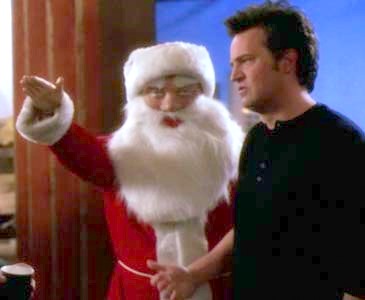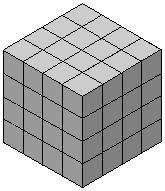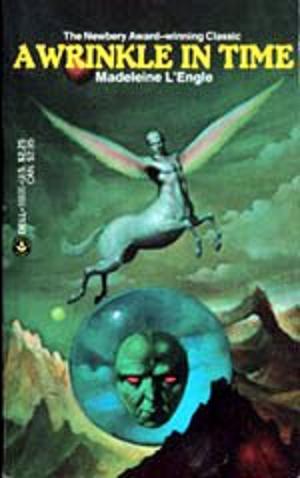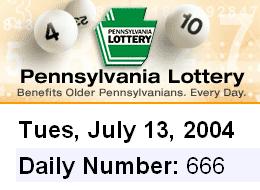Click the image below for "Story Theory and the Number of the Beast"
(the latter, a Heinlein novel).
See also "Story Space."
Click the image below for "Story Theory and the Number of the Beast"
(the latter, a Heinlein novel).
See also "Story Space."
Knock, Knock, Knockin' —
A Scene from "Tomorrowland" —

See August 30, 2002, the day that "Tomorrowland"
actress Raffey Cassidy was born. On that date, this
journal contained the following quotation —
"He's a Mad Scientist and I'm his Beautiful Daughter."
— Deety in Heinlein's The Number of the Beast.
George Clooney and Raffey Cassidy in "Tomorrowland" —

Happy birthday to John Polkinghorne, an English
theoretical physicist, theologian, writer, and Anglican priest.
“For every kind of vampire, there is a kind of cross.” — Gravity’s Rainbow
“I don’t write exclusively on Jewish themes or about Jewish characters.
My collection of short stories, Strange Attractors , contained nine pieces,
five of which were, to some degree, Jewish, and this ratio has provided me
with a precise mathematical answer (for me, still the best kind of answer)
to the question of whether I am a Jewish writer. I am five-ninths a Jewish writer.”
— Rebecca Goldstein, “Against Logic”
Midrashim for Rebecca:
The Diamond Theory vs. the Story Theory (of truth)
Story Theory and the Number of the Beast
The Palm Sunday post “Gray Space”
For those who prefer the diamond theory of truth,
a “precise mathematical” view of a Gray code —
For those who prefer the story theory of truth,
Thursday with the Nashes —
The actors who portrayed Mr. and Mrs. John Nash in
‘A Beautiful Mind’ now portray Mr. and Mrs. Noah…


|
An image related to See "As It Lays" in this journal. (Not as it lies .) |
|
New York Times obituaries today—
Click to enlarge. |

|
"That's GUY-ler, not GAY-ler."
See also Time and the River, Number of the Beast, and Story Theory.
For Dan Brown fans—
Today's midday New York Lottery number was 438.
See page 438 of Heinlein's The Number of the Beast (Fawcett paperback, 1980),
on "ultimate total philosophy."
Other philosophy —

Today's evening New York Lottery number was 772.
See Cheap Diamonds , by Norris Church Mailer, and the symbol
coded (on at least some keyboards) by "Alt 772"—

Alt 772 = ♦
See also Wallace Stevens's "Crude Foyer" in this journal on June 24, 2008 —
the day Cheap Diamonds was published in paperback.
“My pursuits are a joke
in that the universe is a joke.
One has to reflect
the universe faithfully.”
— John Frederick Michell
Feb. 9, 1933 –
April 24, 2009
— Robert A. Heinlein,
The Number of the Beast
For Marisa Tomei
(born Dec. 4, 1964) —
on the day that
Bob Seger turns 64 —
A Joke:
Points All Her Own
Points All Her Own,
Part I:
(For the backstory, see
the Log24 entries and links
on Marisa Tomei’s birthday
last year.)

Points All Her Own,
Part II:
(For the backstory, see
Galois Geometry:
The Simplest Examples.)

Points All Her Own,
Part III:
(For the backstory, see
Geometry of the I Ching
and the history of
Chinese philosophy.)
In simpler terms:


(Here CNAC stands for “China National Aviation Corporation,” an organization that in World War II, as part of the Army Air Transport Command, made high-altitude flights over the Himalayas.)
Related material on poetry:
Related material on space machines:
Serious Numbers
A Yom Kippur
Meditation
"When times are mysterious
Serious numbers
Will always be heard."
— Paul Simon,
"When Numbers Get Serious"
"There is a pleasantly discursive treatment of Pontius Pilate's unanswered question 'What is truth?'"
— H. S. M. Coxeter, introduction to Richard J. Trudeau's remarks on the "story theory" of truth as opposed to the "diamond theory" of truth in The Non-Euclidean Revolution
Trudeau's 1987 book uses the phrase "diamond theory" to denote the philosophical theory, common since Plato and Euclid, that there exist truths (which Trudeau calls "diamonds") that are certain and eternal– for instance, the truth in Euclidean geometry that the sum of a triangle's angles is 180 degrees. As the excerpt below shows, Trudeau prefers what he calls the "story theory" of truth–
"There are no diamonds. People make up stories about what they experience. Stories that catch on are called 'true.'"
(By the way, the phrase "diamond theory" was used earlier, in 1976, as the title of a monograph on geometry of which Coxeter was aware.)

What does this have to do with numbers?
Pilate's skeptical tone suggests he may have shared a certain confusion about geometric truth with thinkers like Trudeau and the slave boy in Plato's Meno. Truth in a different part of mathematics– elementary arithmetic– is perhaps more easily understood, although even there, the existence of what might be called "non-Euclidean number theory"– i.e., arithmetic over finite fields, in which 1+1 can equal zero– might prove baffling to thinkers like Trudeau.
Trudeau's book exhibits, though it does not discuss, a less confusing use of numbers– to mark the location of pages. For some philosophical background on this version of numerical truth that may be of interest to devotees of the Semitic religions on this evening's High Holiday, see Zen and Language Games.
For uses of numbers that are more confusing, see– for instance– the new website The Daily Beast and the old website Story Theory and the Number of the Beast.
Part I:
The Gauntlet
On Jonah Goldberg's new book Liberal Fascism– an attack on, among others, Woodrow Wilson:
"'… at some point,' Goldberg writes, 'it is necessary to throw down the gauntlet, to draw a line in the sand, to set a boundary, to cry at long last, "Enough is enough."'"
Today's Doonesbury:

Part III:
A Holiday Tradition
SUMMERS: When the country needs men up there who know and have courage as it never did before, he's just gonna decorate a chair and get himself honored.
DARRELL: Oh, but he'll vote! Sure. Just like his colleague tells him to.
DIZ: "Yes, sir," like a Christmas tiger. He'll nod his head and vote…
REPORTERS: "Yes."
DIZ: You're not a Senator! You're an honorary stooge! You ought to be shown up!
Part IV:
The Tigers of Princeton
The Christmas number may also be interpreted as a reference to 6/6/6, the graduation date of the Class of 2006 at Princeton University.
For another heraldic emblem
related, if only in this journal,
to Princeton, see
Religious Symbolism
at Princeton:

Goldberg might prefer,
for his Heil,
the following variation:
|
Fahne, |
Dr. Mengele, |
Click on the Fahne (flag)
for further details.
Goldberg might also enjoy

Santa from Aaron Sorkin's
Studio 60 on the Sunset Strip
Related material:

See also the noir entry on "Nightmare Alley" for Winter Solstice 2002, as well as a solstice-related commentary on I Ching Hexagram 41, Decrease. |
Part II:
Language Game
on Christmas Day
Pennsylvania Lottery
December 25, 2007:

Part III:
A Wonderful Life
This verse is sometimes cited as influencing the Protestant conclusion of the Lord's Prayer:
"Thine is the kingdom, and the power, and the glory, forever" (Mt 6.13b; compare 1 Chr 29.11-13)….
This traditional epilogue to the Lord's prayer protects the petition for the coming of the kingdom from being understood as an exorcism, which we derive from the Jewish prayer, the Kaddish, which belonged at the time to the synagogical liturgy.
The Pennsylvania Lottery on Christmas evening paired 173 with the beastly number 0666. The latter number suggests that perhaps being "understood as an exorcism" might not, in this case, be such a bad thing. What, therefore, might "173" have to do with exorcism? A search in the context of the phrase "language games" yields a reference to Wittgenstein's Zettel, section 173:
From Charles L. Creegan, Wittgenstein and Kierkegaard:
Language-
games give general guidelines of the application of language. Wittgenstein suggests that there are innumerably many language- games: innumerably many kinds of use of the components of language.24 The grammar of the language- game influences the possible relations of words, and things, within that game. But the players may modify the rules gradually. Some utterances within a given language- game are applications; others are 'grammatical remarks' or definitions of what is or should be possible. (Hence Wittgenstein's remark, 'Theology as grammar'25 – the grammar of religion.) The idea of the 'form of life' is a reminder about even more basic phenomena. It is clearly bound up with the idea of language. (Language and 'form of life' are explicitly connected in four of the five passages from the Investigations in which the term 'form of life' appears.) Just as grammar is subject to change through language-
uses, so 'form of life' is subject to change through changes in language. (The Copernican revolution is a paradigm case of this.) Nevertheless, 'form of life' expresses a deeper level of 'agreement.' It is the level of 'what has to be accepted, the given.'26 This is an agreement prior to agreement in opinions and decisions. Not everything can be doubted or judged at once. This suggests that 'form of life' does not denote static phenomena of fixed scope. Rather, it serves to remind us of the general need for context in our activity of meaning. But the context of our meaning is a constantly changing mosaic involving both broad strokes and fine-
grained distinctions. The more commonly understood point of the 'Private Language Argument' – concerning the root of meaning in something public – comes into play here. But it is important to show just what public phenomenon Wittgenstein has in mind. He remarks: 'Only in the stream of thought and life do words have meaning.'27
- 24
- Investigations, sec. 23.
- 25
- Investigations, sec. 373; compare Zettel, sec. 717.
- 26
- Investigations, p. 226e.
- 27
- Zettel, sec. 173. The thought is expressed many times in similar words.
And from an earlier chapter of Creegan:
The 'possibility of religion' manifested itself in considerable reading of religious works, and this in a person who chose his reading matter very carefully. Drury's recollections include conversations about Thomas à Kempis, Samuel Johnson's Prayers, Karl Barth, and, many times, the New Testament, which Wittgenstein had clearly read often and thought about.25 Wittgenstein had also thought about what it would mean to be a Christian. Some time during the 1930s, he remarked to Drury: 'There is a sense in which you and I are both Christians.'26 In this context it is certainly worth noting that he had for a time said the Lord's Prayer each day.27
Wittgenstein's last words were: 'Tell them I've had a wonderful life!'28
- 25
- Drury (1981) 'Conversations with Wittgenstein,' in Ludwig Wittgenstein: Personal Recollections, pp. 112ff.
- 26
- Drury, 'Conversations,' p. 130.
- 27
- Drury, 'Some notes,' p. 109.
- 28
- Reported by Mrs. Bevan, the wife of the doctor in whose house Wittgenstein was staying. Malcolm, Memoir, p. 81.
Part IV:
For more on the Christmas evening
number of the beast, see Dec. 3:
"Santa's Polar Opposite?" —

See last year’s
entries for 5/10 —
My Space

and for 2/23 —
Cubist Epiphany
“This is a crazy world and
the only way to enjoy it
is to treat it as a joke.”
— Robert A. Heinlein,
The Number of the Beast
For the next generation:
— Robert A. Heinlein,
The Number of the Beast
Some websites on zeta functions (a classic topic of considerable current interest):
"Does the word 'tesseract'
mean anything to you?"
— Robert A. Heinlein in
The Number of the Beast
(1980)
My reply–
Part I:

A Wrinkle in Time, by
Madeleine L'Engle
(first published in 1962)
Part II:

Diamond Theory in 1937
and
Geometry of the 4×4 Square
Part III:
"Wells and trees were dedicated to saints. But the offerings at many wells and trees were to something other than the saint; had it not been so they would not have been, as we find they often were, forbidden. Within this double and intertwined life existed those other capacities, of which we know more now, but of which we still know little– clairvoyance, clairaudience, foresight, telepathy."
— Charles Williams, Witchcraft, Faber and Faber, London, 1941
A New Yorker profile of Madeleine L'Engle from April 2004, which I found tonight online for the first time. For a related reflection on truth, stories, and values, see Saint's Day. For a wider context, see the Log24 entries of February 1-15, 2003 and February 1-15, 2006.
“… we have condensed six dimensions into four, then we either work by analogy into six, or we have to use math that apparently nobody but Jake and my cousin Ed understands. Unless you can think of some way to project six dimensions into three– you seem to be smart at such projections.”
I closed my eyes and thought hard. “Zebbie, I don’t think it can be done. Maybe Escher could have done it.”

The above screenshot shows a
moveable JavaScript display
of a space of six dimensions
(over the 2-element field).
(To see how the display works,
try the Kaleidoscope Puzzle first.)
Compare and contrast:
Solomon’s Cube, the five
Log24 entries ending on 3/14,
and the
American Mathematical Society
on Mathematical Imagery.
Related material:
A more extensive excerpt from
The Number of the Beast, and
Story
There is one story
and one story only
That will prove
worth your telling….
— Robert Graves,
“To Juan at the Winter Solstice”
“To many, mathematicians have come to resemble an esoteric sect, whose members alone have access to secret otherworldly mysteries.
All of us who came to Mykonos believed that this is an unfortunate situation. Mathematics is an inseparable part of human culture, and should be viewed and treated as such. Our underlying assumption was that mathematical reasoning had something important in common with that quintessential human activity – story-telling. But what this means, and what kind of connections can be drawn between the two, remained to be sorted out.”
Flashback to
Harrison Ford’s birthday
a year earlier:

“He’s a Mad Scientist and
I’m his Beautiful Daughter.”
— Deety in Heinlein’s
The Number of the Beast.
“If you have ever loved a book
so much that you began to
believe that it continued on
in its own world
even after you put it down,
this book could be for you.”
— Jodi Russell, review of
Number of the Beast
These last two quotations
are from
Story Theory and
the Number of the Beast,
by Steven H. Cullinane on
December 21, 2001.
Related material:
See Lucky(?) Numbers,
yesterday’s Pennsylvania lottery,
and the previous entry.
"Just the facts, ma'am" — Joe Friday
See the entry Lucky (?) Numbers of Saturday, April 2, 2005, 11:07 AM ET, for links to a few facts about the historical role of the Number of the Beast in the Pennsylvania Lottery.
The Pennsylvania Lottery mid-day drawings take place at about 1:10 PM ET.
Pope John Paul II died on Saturday, April 2, at 2:37 PM ET.
Thus the final PA drawing of his lifetime was on that Saturday afternoon.
The winning mid-day number that day was…
In the I Ching, this is the number of
The Power of the Great.
Neuhaus stated that "If any phrase encapsulates the message that John Paul declared to the world, it is probably 'prophetic humanism.'" If there is such a thing, it is probably best exemplified by the I Ching. For further details, see Hitler's Still Point.
Father Neuhaus's argument included the following mysterious phrase:
"God's unfolding covenant with Abraham, Isaac, Jacob and Jesus."
Compare the following two passages from Holy Scripture:
"…behold behind him
a ram caught in a thicket by his horns"
"A goat butts against a hedge
And gets its horns entangled."
A topic for discussion by the foolish:
In the current historical situation,
who is Isaac and who is the goat?
From yet another Holy Scripture,
a topic for discussion by the wise:
“Anyone can create a pretty little bamboo garden in the world. But I doubt that the gardener would succeed in incorporating the world in his bamboo grove.”
Reply to Lucifer
The New York State Lottery evening number for Saturday, September 6, 2003, was
666.
See last year’s entries for Mary Shelley’s birthday,
These were written partly in response to the New York State Lottery midday number for Monday, August 26, 2002, which was also
666.
In reply to that occurrence, I commented on the website
 |
In reply to last Saturday’s return of the beastly lottery number, I recommend the following links on software guru Bill Joy:
Sept. 9 – Sun Co-founder Joy Steps Down:
“Joy co-founded Sun, originally an acronym for Stanford University Network, with McNealy in 1982. Before that, Joy was the designer of the Berkeley version of the Unix operating system and helped pioneer the concept of open source.
More recently, Joy found himself at the center of controversy after he wrote a Wired magazine article on the challenges posed to mankind by new technologies such as nanotechnology, robotics and genetic engineering.”
and
Joy’s April 2000 Wired article, titled
Why the future doesn’t need us:
Our most powerful 21st-century technologies – robotics, genetic engineering, and nanotech – are threatening to make humans an endangered species.
Joy says
“I can date the onset of my unease to the day I met Ray Kurzweil….”
I, too, can date, at least approximately, an encounter with the philosophy of
transhumanism (a Lucifer Media link)
that Kurzweil embraces… It was sometime in the first half of January, 1989… I know this because January 9, 1989, is the date of The New Yorker’s review of Hans Moravec’s Mind Children: The Future of Robot and Human Intelligence (Harvard University Press).
Brad Leithauser, reviewing Mind Children, says that if Moravec “is correct in supposing that human minds will be transferred into or otherwise fused with machines, it seems likely that traditional religious questions — and traditional religions themselves — will either melt away or suffer wholesale metamorphosis. Debates about Heaven or Hell — to take but one example — would hold little relevance for an immortal creature.”
Au contraire. Immortal creatures– such as, according to Christianity, human beings– are the only creatures for whom such debates hold relevance.
For an example of such a debate, see
The Contrasting Worldviews of
Sigmund Freud and C.S. Lewis,
by Harvard psychiatrist Armand Nicholi.
For more on Nicholi, see my entry of August 19, 2003,
For the temple tablet associated with Nicholi in that entry, see my entry of September 6, 2003 (the NY Lottery “666” date),
To sum up this entry, a phrase of C. S. Lewis seems appropriate:
Mental Health Month, Day 27:
Conspiracy Theory and
Solomon's Seal
In our journey through Mental Health Month, we have now arrived at day 27. This number, the number of lines on a non-singular cubic surface in complex projective 3-space, suggests it may be time to recall the following note (a sort of syllabus for an imaginary course) from August 1997, the month that the Mel Gibson film "Conspiracy Theory" was released.

Conspiracy Theory 101
August 13, 1997
Fiction:
| (A) | Masks of the Illuminati, by Robert Anton Wilson, Pocket Books, New York, 1981. Freemasonry meets The Force (starring James Joyce and Albert Einstein). |
| (B) | The Number of the Beast, by Robert A. Heinlein, Ballantine Books, New York, 1980. "Pantheistic multiple solipsism" and transformation groups in n-dimensional space combine to yield "the ultimate total philosophy." (p. 438). |
| (C) | The Essential Blake, edited by Stanley Kunitz, MJF Books, New York, 1987. "Fearful symmetry" in context. |
Fact:
| (1) | The Cosmic Trigger, by Robert Anton Wilson, Falcon Press, Phoenix, 1986 (first published 1977). Page 245 reveals that "the most comprehensive conspiracy theory," that of the physicist Sir Arthur Eddington, is remarkably similar to Heinlein's theory in (B) above. |
| (2) | The Development of Mathematics, by E. T. Bell, 2nd. ed., McGraw-Hill, New York, 1945. See the discussion of "Solomon's seal," a geometric configuration in complex projective 3-space. This is as good a candidate as any for Wilson's "Holy Guardian Angel" in (A) above. |
| (3) | Finite Projective Spaces of Three Dimensions, by J. W. P. Hirschfeld, Clarendon Press, Oxford, 1985. Chapter 20 shows how to represent Solomon's seal in the 63-point 5-dimensional projective space over the 2-element field. (The corresponding 6-dimensional affine space, with 64 points, is reminiscent of Heinlein's 6-dimensional space.) |
|
See also China's 3,000-year-old "Book of Transformations," the I Ching, for more philosophy and lore of the affine 6-dimensional space over the binary field. © 1997 S. H. Cullinane |
For a more up-to-date and detailed look at the mathematics mentioned above, see
Abstract Configurations
in Algebraic Geometry,
by Igor Dolgachev.
"Art isn't easy." — Stephen Sondheim
The Number of the Beast
"He's a Mad Scientist and I'm his Beautiful Daughter."
— Deety in Heinlein's The Number of the Beast.
For more on this theme, see my Journal Note of December 21, 2001. See also the film classic "Forbidden Planet," and the play "The Tempest," by William Shakespeare, on which it is based.
Philosophers ponder the idea of identity: what it is to give something a name on Monday and have it respond to that name on Friday….
— Bernard Holland, The New York Times of Monday, May 20, 1996
The New York midday lottery number for Monday, August 26, 2002, was 666, the biblical "number of the beast."
For the beast's Friday response to the calling of its number by New York State on Monday, see

|
Lucifer Media Corporation. |
Powered by WordPress